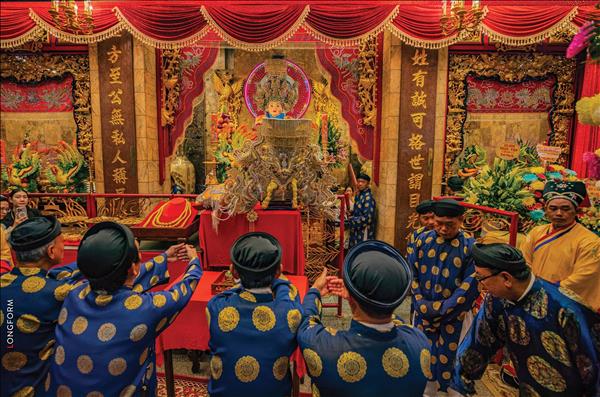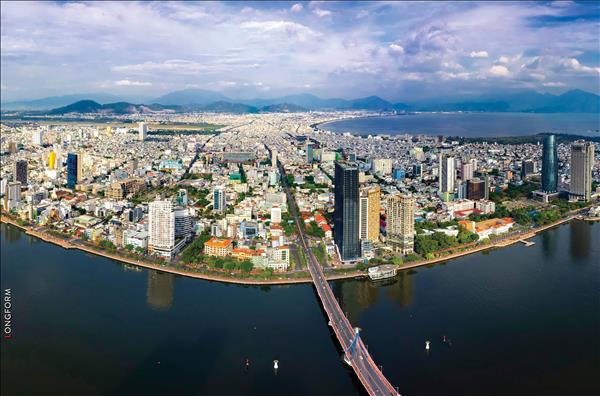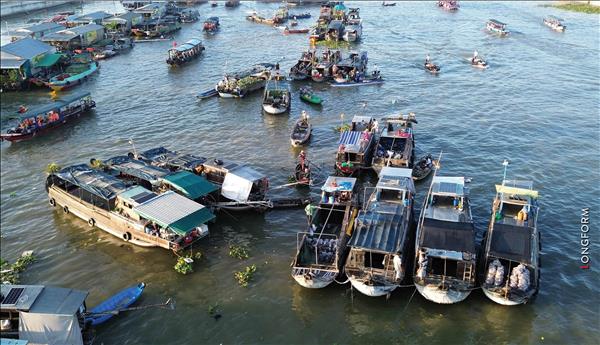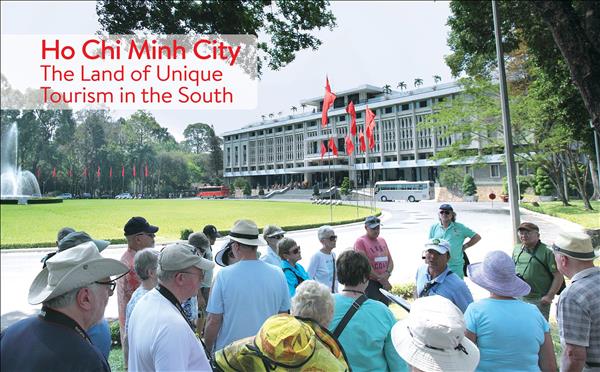Hanoi is considered an area that has effectively used the Official Development Assistance (ODA) fund, especially in the construction of the traffic infrastructure. Thanks to this, the image of the urban traffic infrastructure in Hanoi has had great changes and has become more modern and comprehensive.
Opening the traffic bottlenecks
The capital of Hanoi is the political, economic and cultural centre of Vietnam. In recent years it has attracted a large number of people from other areas coming to work and settle. According to the statistics of the General Office for Population Family Planning, in 2012 the population of Hanoi reached over seven million people. Its large population has caused many difficulties, such as in housing, the environment and employment and especially with traffic problems.
Nearly 10 years ago, Hanoians endured traffic jams at some hot spots, such as the section from Phap Van Road to Giai Phong Road at the southern gate to the city, Kim Lien Crossroads, Nga Tu So and Lang Road. In these situations the State and the Hanoi City authority set out suitable solutions, including expanding the capital’s boundaries (2008), building and upgrading the infrastructure with special focus on the traffic projects. However, due to the limited budget, the traffic infrastructure was not solved systematically.
To solve the problem, Hanoi has mobilized the ODA. Transport has always been given top priority in ODA-funded projects. By the end of 2012, ODA funds for traffic in Hanoi accounted for 36.28% of the ODA disbursement (over 1.8 billion USD).
The capital of Hanoi is the political, economic and cultural centre of Vietnam. In recent years it has attracted a large number of people from other areas coming to work and settle. According to the statistics of the General Office for Population Family Planning, in 2012 the population of Hanoi reached over seven million people. Its large population has caused many difficulties, such as in housing, the environment and employment and especially with traffic problems.
Nearly 10 years ago, Hanoians endured traffic jams at some hot spots, such as the section from Phap Van Road to Giai Phong Road at the southern gate to the city, Kim Lien Crossroads, Nga Tu So and Lang Road. In these situations the State and the Hanoi City authority set out suitable solutions, including expanding the capital’s boundaries (2008), building and upgrading the infrastructure with special focus on the traffic projects. However, due to the limited budget, the traffic infrastructure was not solved systematically.
To solve the problem, Hanoi has mobilized the ODA. Transport has always been given top priority in ODA-funded projects. By the end of 2012, ODA funds for traffic in Hanoi accounted for 36.28% of the ODA disbursement (over 1.8 billion USD).
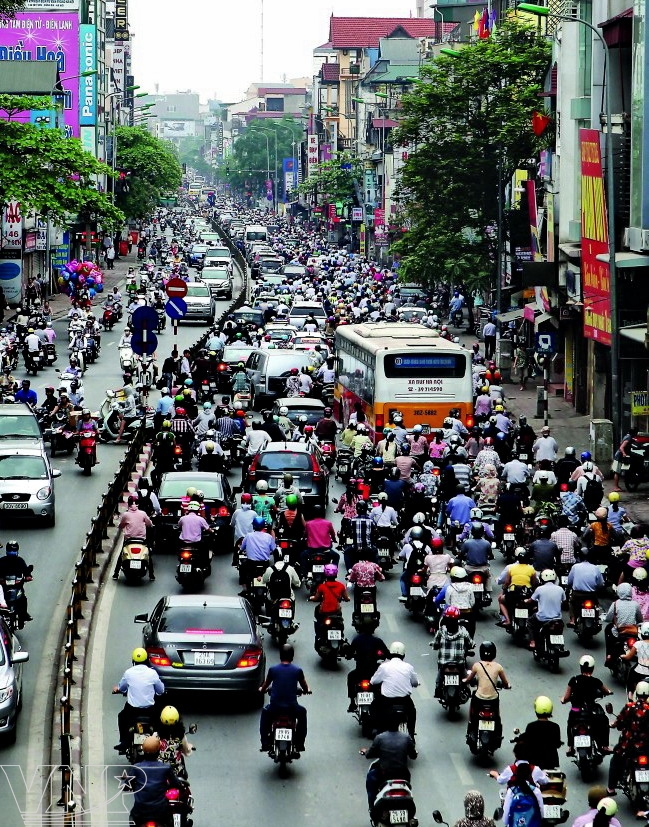 A large population puts much pressure on transport in Hanoi. Photo: Tat Son 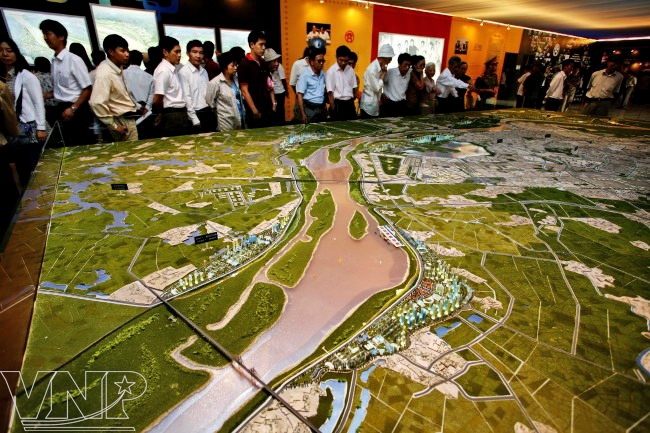 The sand table of planning and expanding Hanoi administrative boundaries and transport system. Photo: Hoang Ha 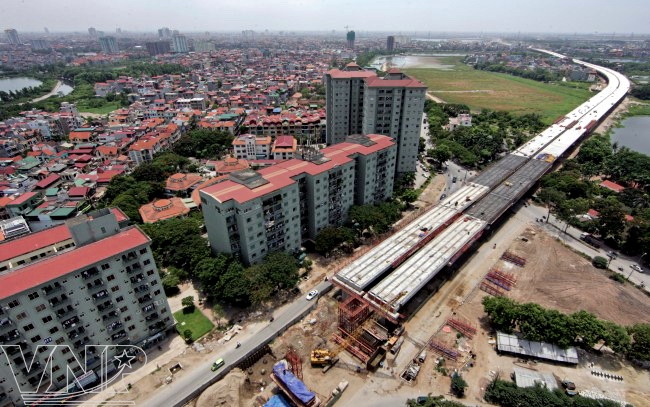 A part of Belt Road No.3 at the section of Northern Linh Dam Lake. Photo: Trong Chinh 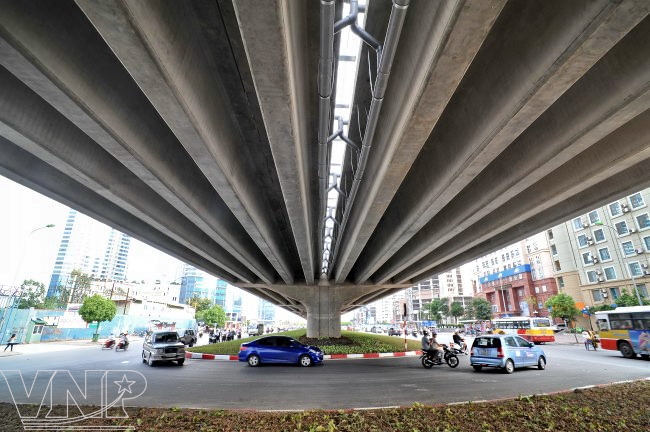 The flyover highway above the section of Mai Dich-Northern Linh Dam Lake on Belt Road No.3, 9km long, is the most modern one in Vietnam using ODA from Japan. Photo: Tran Thanh Giang 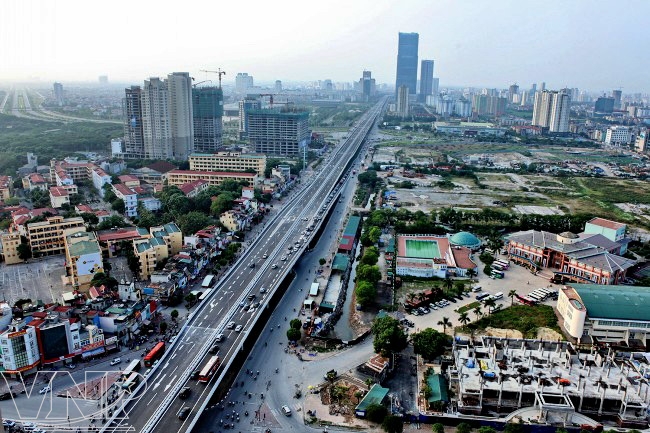 The flyover highway above the section of My Dinh Area on Belt Road No.3. Photo: Cong Dat 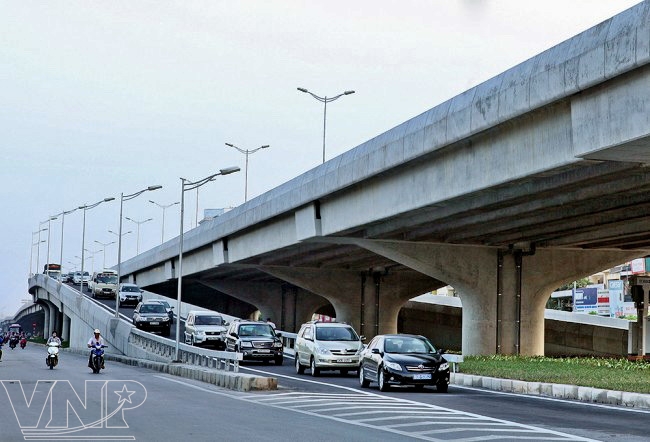 One of the off ramps from Belt Road No.3. Photo: Cong Dat 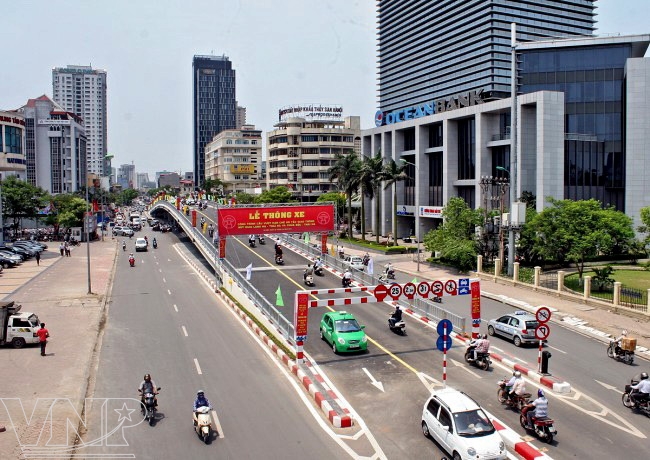 Passover at Lang Ha-Thai Ha traffic bottleneck. Photo: Cong Dat 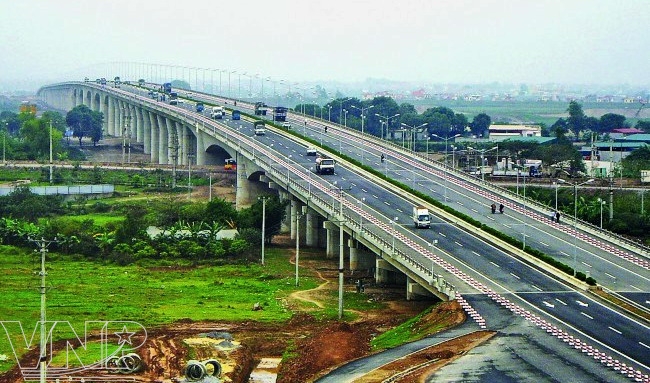 Thanh Tri Bridge, crossing over the Red River, is constructed using ODA from Japan. Photo: JICA’s file 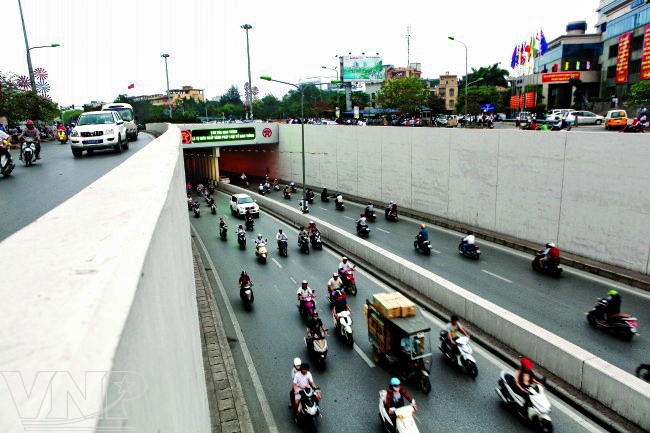 Kim Lien Tunnel. Photo: Tat Son 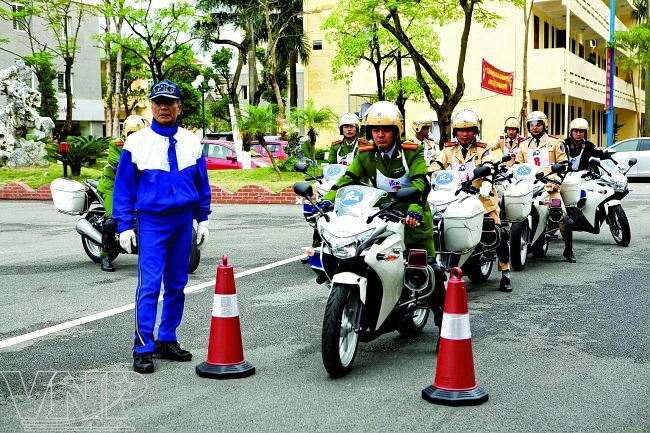 A Japanese expert trains Hanoi traffic police to improve their traffic control skills. Photo: JICA’s file |
| «...
Some major traffic projects in Hanoi using ODA from Japan
- Thanh Tri Bridge is 12,000m long and 33.1m wide with six lanes capitalized at 410 million dollars. - Belt Road No.3, 9km long, is worth over 300 million dollars. - Nga Tu So Overpass. - Kim Lien Tunnel. - Nhat Tan Bridge. - Noi Bai International Airport Terminal 2. |
In 2012, with ODA, Hanoi built and put into use 5/18 overpasses at the intersections of Chua Boc – Tay Son, Lang Ha – Huynh Thuc Khang, Lang – Le Van Luong, Lang – Tran Duy Hung and Nam Hong Crossroads. Talking about the effectiveness of these projects, Captain Nguyen Phuong Nam at the Hanoi Traffic Police Department, who is in charge of traffic control at the Chua Boc – Tay Son intersections, said: “Previously, there were serious traffic jams at this place. Since the overpasses were put into operation, the division of lanes has been easier and the waiting time for the red light has been shortened, thus considerably reducing the traffic jams.”
Besides the traffic projects built with ODA funds, the traffic software projects have also been proven effective. Japan is a pioneer in investing in traffic soft skills with the project “Northern Vietnam National Roads Traffic Safety Improvement” with 65 million USD in loans from the Japanese International Cooperation Agency (JICA).
Takao Inami, consulting director of this project said: “Our project was implemented in 10 provinces and cities, focusing on Hanoi. Now we are organizing several training courses on capacity enhancement for over 300 traffic policemen in Hanoi. In addition, we have organized 18 training courses on traffic safety for over 900 cadres and 30,204 people in many surrounding provinces and cities.”
Recently, during a visit to some Japanese ODA projects in Hanoi, Tsuno Motonori, Chief Representative of JICA Office in Vietnam said: “Hanoi has used effectively the ODA of the Japanese Government. These projects will help establish a part of a modern traffic system in Hanoi, improve the transport system of goods, solve traffic jams and contribute to the socio-economic development of the city.”
Key projects
At the Consultative Group Meeting held at the end of 2012, the bilateral and multilateral sponsors pledged to continue providing ODA for Vietnam with about 6.5 billion USD in the fiscal year 2013, of which Japan alone pledged to provide about 2.6 billion USD, focusing on the development of the infrastructure and training of human resources.
Hanoi is concentrating on two key projects built with the Japanese Government’s ODA. They include the Nhat Tan Bridge and Terminal 2 of Noi Bai International Airport.
The Nhat Tan Bridge has been defined by the Government as a national key project. As designed, it is a six-span cable-stayed bridge with a total length of 1,500m. It has five gigantic towers which are 110m high, symbolizing the five city gates of Hanoi. The bridge has a unique structure of multi-spans which will be a prominent structure in the history of bridges in the world.
Kenji Matsuno, Deputy Managing Director of the partnership of IHI and Sumitomo Mitsui (Japan), said: “Nhat Tan Bridge is highly aesthetic, so in the past time the construction units have made great efforts to ensure the progress and quality of the project. With the current progress, the contractors have pledged to complete and put the bridge into operation by the end of 2014.”
After completion, the Nhat Tan Bridge will connect downtown Hanoi with the northern provinces and the industrial parks in North Thang Long, Dong Anh, Co Loa, Gia Lam and Yen Vien. In the future, together with this bridge, the belt Road No.2 will be completed, thus shortening the route from downtown Hanoi to Noi Bai International Airport. Nhat Tan Bridge will be the longest cable-stayed bridge in Vietnam and will be a focal point in the landscape architecture of the capital.
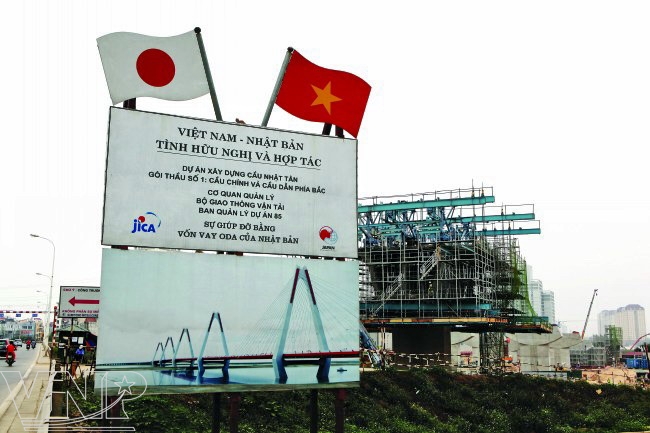 At the construction site of Nhat Tan Bridge. Photo: Tat Son 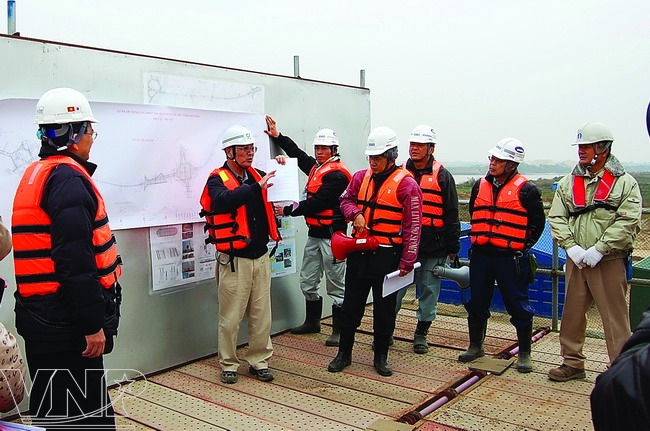 Tsuno Notomori (1st from right) - Chief Representative of JICA Vietnam inspects the construction progress of Nhat Tan Bridge. Photo: JICA’s file. 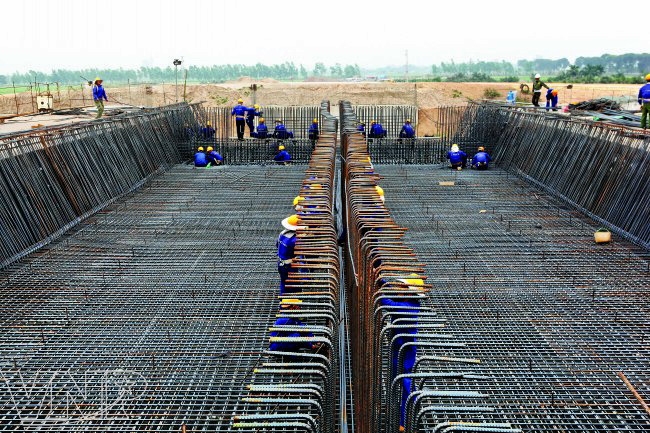 Building steel structures of Nhat Tan Bridge. Photo: Tat Son 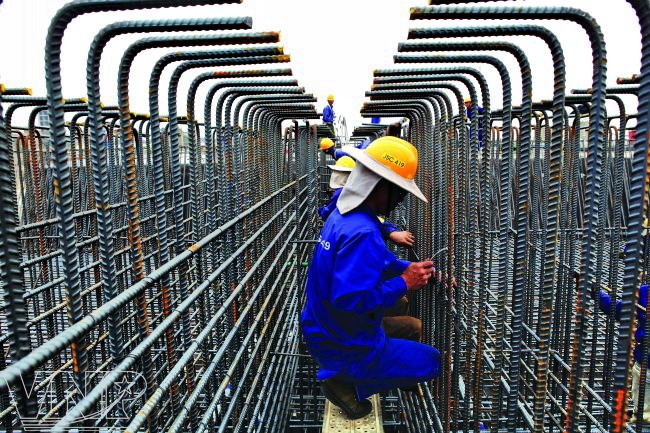 Nhat Tan Bridge is under construction. Photo: Tat Son 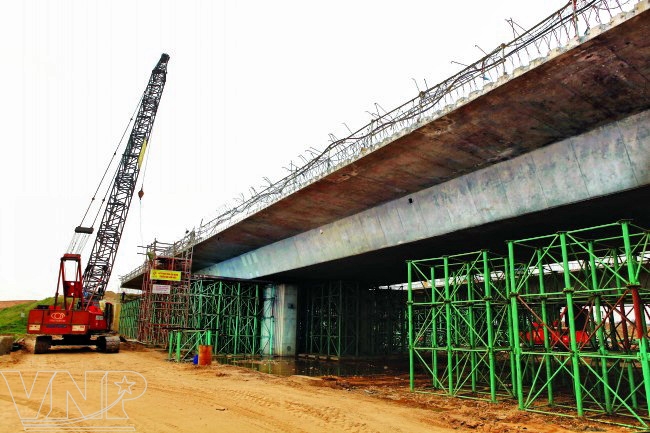 Building concrete beams of Nhat Tan Bridge. Photo: Tat Son 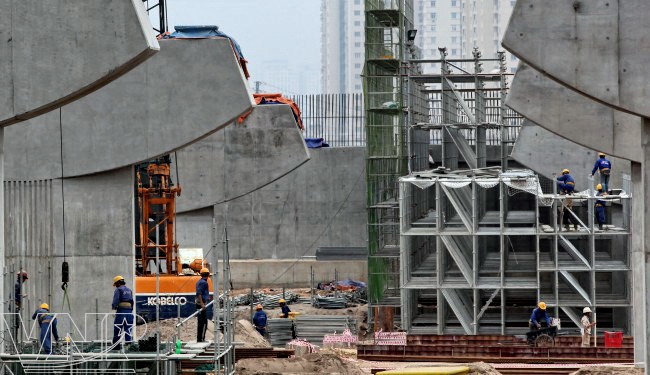 A system of piers of Nhat Tan Bridge. Photo: Tat Son  With joint efforts made by Vietnamese and Japanese contractors, Nhat Tan Bridge will be put into operation in 2014. Photo: Tat Son 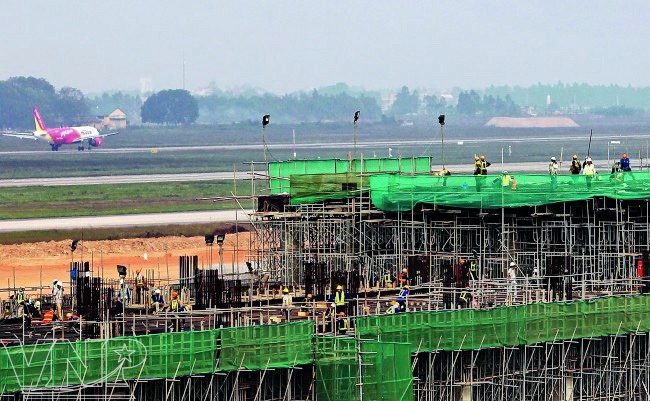 Noi Bai International Airport Terminal 2 is built in close coordination with Japanese construction experts and Vietnamese contractors. Photo: Tat Son 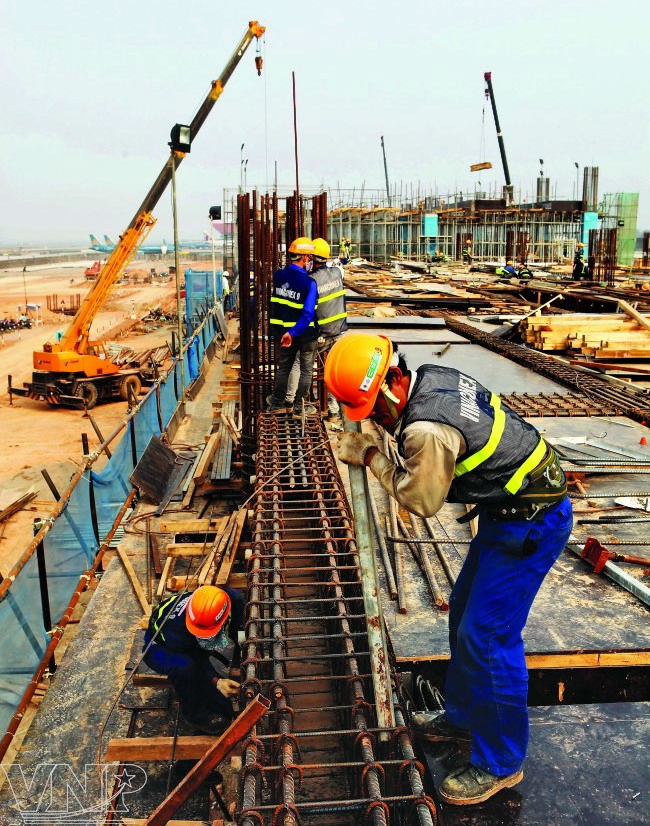 Building steel structures of Noi Bai International Airport Terminal 2. Photo: Tat Son 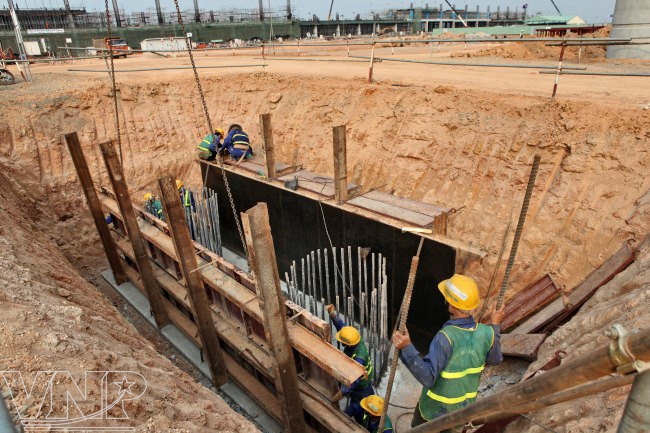 Building a foundation buttress of Noi Bai International Airport Terminal 2. Photo: Tat Son 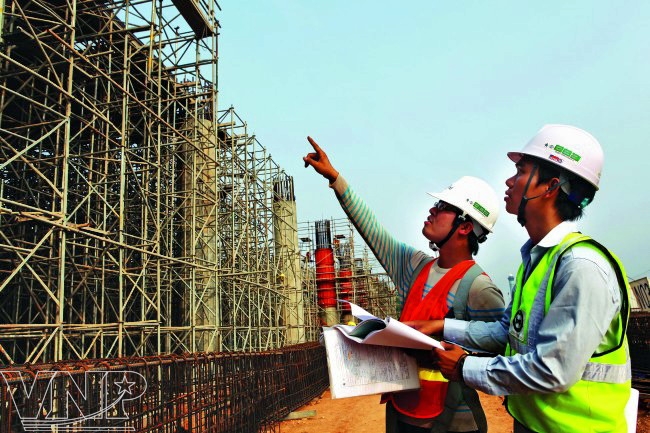 Japanese experts and Vietnamese contractors inspect the construction proccess of Noi Bai International Airport Terminal 2. Photo: Tat Son 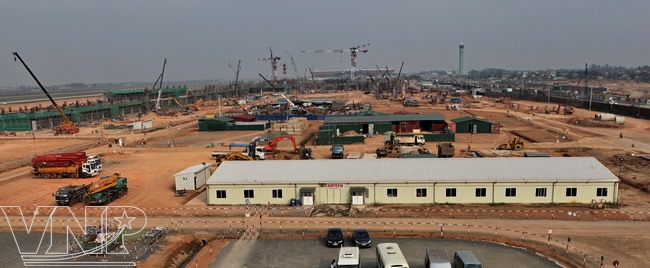 Panoramic view of Noi Bai International Airport Terminal 2. Photo: Tat Son |
Under the introduction of JICA in Vietnam we visited the project of Noi Bai International Airport Terminal 2. This project has a total investment capital of nearly 900 million USD, including nearly 700 million USD from Japan’s ODA. As designed, Terminal 2 has four floors with a total area of 139,000m2 and a capacity of handling 10 million passengers / year. It is expected that this project will be completed in November 2014 and will reduce the burden of the overloaded Terminal 1.
According to JICA in Vietnam, the Japanese Government said that besides ODA, Japan would provide support and transfer the large project construction technology to Vietnam. This is clearly shown at the Nhat Tan Bridge and Terminal 2 projects where the Vietnamese and Japanese contractors have coordinated to build the world’s most advanced construction technology of traffic projects.
Some people compare the construction of a traffic infrastructure in Hanoi is like building “a house”, the ODA is a source of capital for Hanoi to complete the southern facade of “the house” with the projects which have operated effectively, such as Belt Road No.3, and the northern facade with key projects, such as the Nhat Tan Bridge and Terminal 2. A system of urban overpasses and the traffic soft skill support projects are an important part of “the interior” of the house.
“The traffic house” in Hanoi is being completed with an important contribution of ODA, especially the Japanese Government’s ODA for Vietnam. The appearance of more and more modern traffic projects in the capital not only confirms that Hanoi has effectively used the ODA source but it also shows the friendship between the two strategic partners, Vietnam and Japan. This is an important focal point in the celebration of the 40th anniversary of diplomatic ties between the two countries (1973 – 2013).
Story: Thong Thien - Photos: Tat Son & Cong Dat and JICA’s files
bdAnh

